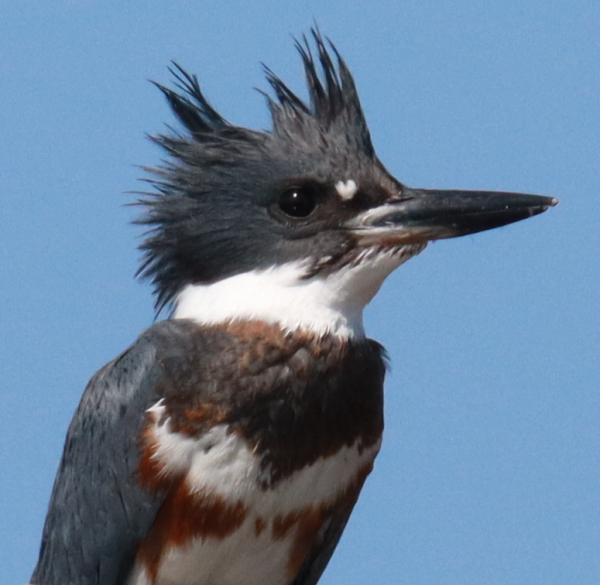
A number of Belted Kingfishers were present in the area last week, but only an obliging female provided photo opportunities, including a close portrait.
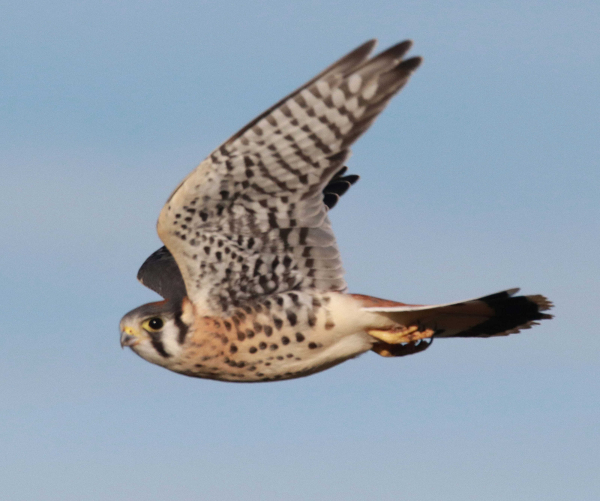
American Kestrels seem to be making a migration stop along the nearby western edge of the Drift Plain with as many as 12 counted last week during a single hour.
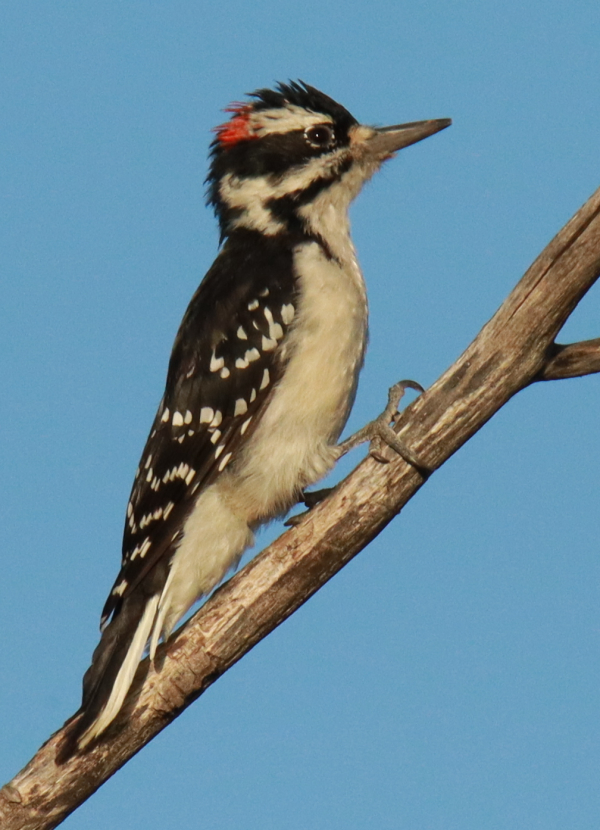
An active male Hairy Woodpecker provided a photo opportunity as it moved along a couple small branches of the “skeleton tree” Thursday afternoon.
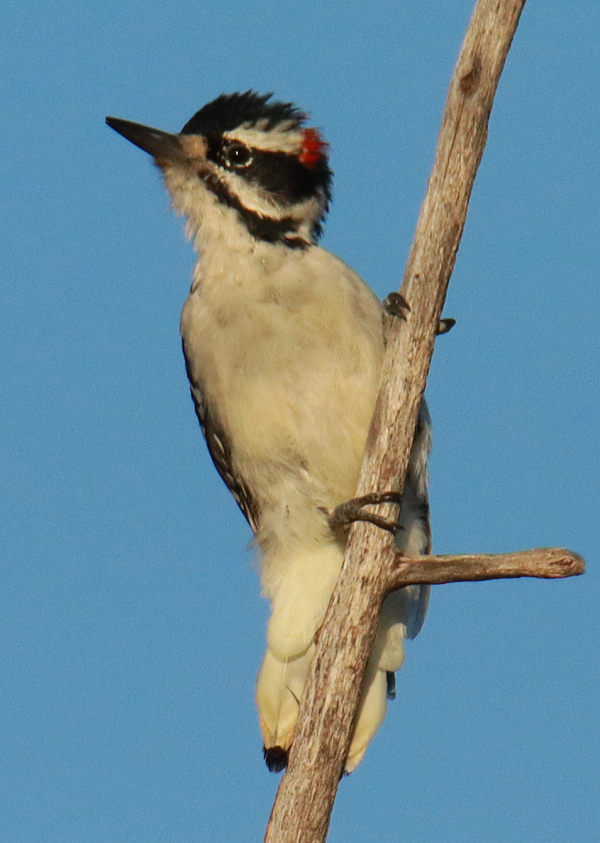
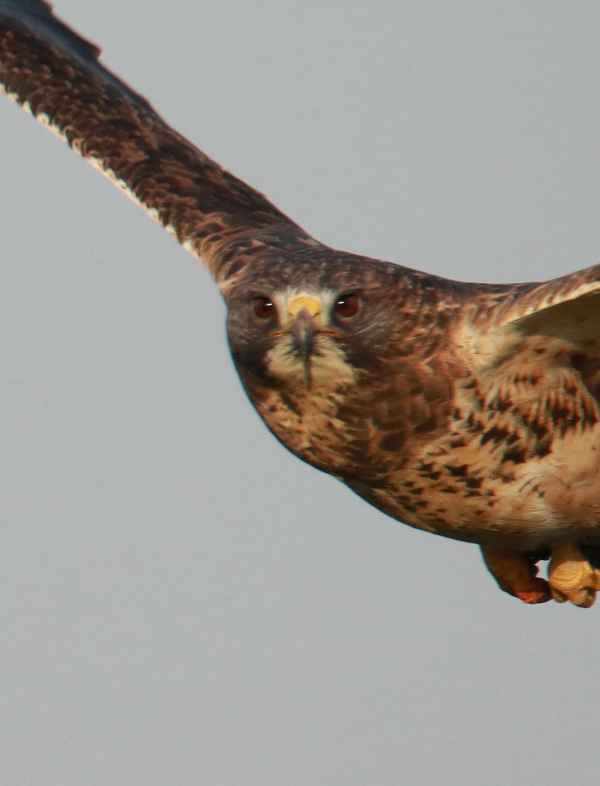
A head-on view as a Swainson’s Hawk flew toward me just a mile south of home.
|
Fall migration continues to be a trickle in the northern Great Plains, but it’s been complimented by some interesting new birds including Belted Kingfishers, Blue Jays, and American Kestrels in addition to Killdeer, Ring-billed and Franklin’s Gulls, Mourning Doves, American Robins, Northern Flickers, and Red-tailed Hawks. Kestrels may actually be more than a trickle for this area, numbering 12 Thursday and 10 Friday along what I am referring to the ‘Kestrel Route,’ which is an abbreviated portion of the ‘Southeast Raptor Route.’
Almost all the kestrels were sighted in the lower, level Drift Plain, with only 1 and 2 mini-falcons observed in the adjacent higher, hilly Coteau. That has been a pretty common occurrence and point of interest for American Kestrels and Red-headed Woodpeckers over the years. My initial focus on returning to the southeast area a few times last week was to check for birds perched at the “skeleton tree,” where I’ve been able to photograph a variety of birds perched in the barkless gray-white branches, which was emphasized when I photographed a Sharp-shinned Hawk there last week.
During the first drive, in addition to the kestrels I encountered 8 Red-tailed Hawks, 4 Swainson’s Hawks, 3 Northern Harriers, an American Bittern, 2 Blue Jays, a standout flock of about 15 Western Meadowlarks in addition to scattered meadowlarks along the way; and a flock of 10 Wilson’s Snipe that popped up from a nearby marsh a couple times as I waited for a Belted Kingfisher to return to a favored perch was another interesting sighting. There was also a flock of about 40 Killdeer resting at Charo Marsh, and a scattering of Mourning Doves along the way. A male Hairy Woodpecker turned out to be the best photo subject Thursday – active at the skeleton tree no less, and during primetime sunlight too: 6pm in my area now.
Sunday I checked back along a shortened version of the “Kestrel Route” and sighted a flock of 21 Blue Jays near the location where I saw 2 Thursday; along with 3 Northern Flickers and what seemed to be a regular scattering of kestrels and hawks although I didn’t count raptors. The skeleton tree was bare though, and I realized that during the 3 visits to the edge of the Drift Plain Thursday, Friday, and Sunday there were no Red-headed Woodpecker sightings, suggesting this species has initiated migration too. It was also obvious that some new waterfowl arrived Sunday, when I observed many Redheads with a few Canvasbacks among them at one lake, and 4 male Buffleheads among a mix of American Wigeons, Northern Pintails, and Mallards. I also noted a lack of Ruddy Ducks in the area.
As for Belted Kingfishers, none were open to my interest in photographing them until I found a female near my friend Dave’s farmstead. The light was pretty good during my late morning observations while the kingfisher watched the shallow marsh below her perch – eventually taking flight that ended in an abrupt turn downward behind a veil of cattails. When she flew almost directly upward to perch, I could see she had a relatively large fish in it beak, large for the kingfisher, who swallowed it before I left.
The weather over the last week has been spectacular, and Saturday may have been the best of days for a birding drive, so how could I resist but to hit the road a bit earlier than usual and head west for the Missouri River, then north to the Badlands outcrop I like to check, and east to Long Lake National Wildlife Refuge. I was surprised not to find an American Kestrel along that elongated route, and Swainson’s Hawks seemed to be scarce with only 5 making a show, but there were 24 Red-tailed Hawks and 3 Northern Harriers along the way, plus an adult Bald Eagle at the refuge that was carrying an American Coot. Turkey Vultures were apparent, including a group of 3, 2 singles, and eventually a group of 6 that gathered around a road kill to feed.
Long Lake provided my first look at a sizeable flock of Sandhill Cranes, one of my focus species for visiting the refuge. There were about 75 Sandhills feeding in a grain stubble field by the time I arrived about 6pm, and it was a special opportunity to hear the wild calls of cranes again. I also took a look at a large flock of resting Canada Geese and was a bit surprised to see and hear a few White-fronted Geese among them – the first of the Arctic-nesting geese to arrive (much earlier than the other 3 species – Snows, Ross’s, and Cackling Geese). Small flocks of ducks were active in area marshes and in flights above, and there were still a few White Pelicans on hand along with many Double-crested Cormorants, but no Western or Eared Grebes.
My main photo opportunities were provided by 2 single Great Blue Herons and a raft of about 60 American Coots. There was an impressive convoy of Franklin’s Gulls swarming over the eastern part of the refuge, a few American Avocets and Greater Yellowlegs on hand, and a couple Ring-necked Pheasant roosters in the open. It was a great afternoon for an extended drive across the Coteau and Missouri Slope the last Saturday of September and the first Saturday of the new fall.
Raptormania – I also wanted to point out that it’s been an especially busy migration week, especially as raptors funnel along the northwest Gulf Coast in Texas where Monday more than a quarter million Broad-winged Hawks passed above the Corpus Christi HawkWatch, along with 9 other raptor species. You can check in on the latest daily raptor counts at HawkCount, and it’s always interesting to see how the numbers of raptors build up by looking at the totals for the month of September (Click “Monthly,” “September,” and “Go” on the left column).
In my area, October 1st (today) tends to be the end of the Swainson’s Hawk season, so I doubt I will see many to report to you next week. As it stands, Swainson’s Hawks will be the next species to migrate south past Corpus Christi in largest contingencies, which gives us reason to continue to monitor that migration hotspot. The next stop is Veracruz, Mexico, where remarkable counts continue to be posted, and eventually the Swainson’s will alight in plains of northern Argentina until we see them again in April. With a new month starting today, enjoy any time you can to take a walk, visit a birding spot, or take a drive in the country to experience the heartbeat of the season and the pulse of October bird migration.
Article and Photos by Paul Konrad
Share your bird sightings and photographs at editorstbw2@gmail.com